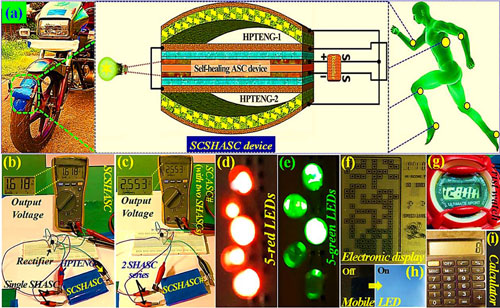| Apr 30, 2019 | |
Self-powered system instantaneously harvests and stores energy |
|
| (Nanowerk Spotlight) The development of portable and wearable multipurpose smart electronics has inspired researchers at the Indian Institute of Technology (IIT) Kharagpur to invent a self-powered system that instantaneously harvests and stores energy. | |
| Currently, it is challenging to integrate two distinct functions like energy harvesting and energy storage into a single miniature power cell. The team from the Materials Science Centre at IIT Kharagpur introduced an exclusive self-charging and self-healing flexible asymmetric supercapacitor power cell proficient to sustainably power-up portable electronics by simply applying mechanical bio-mechanical stresses. | |
| This self-charging power cell/package comprises an asymmetric supercapacitor unit sandwiched in-between two parallel connected triboelectric nanogenerators and reveals exceptional output performances. The researchers demonstrated that their devices can be consistently charged up to ∼1.6 V within 31 minutes under periodic compression (at a fixed force of ∼17.6 N and frequency of ∼3.80 Hz). | |
| Additionally, the asymmetric supercapacitor power cell exhibits remarkable self-healing behavior. Moreover, the researchers validated that their as-designed power package can instantly power-up numerous portable electronic appliances and LEDs on periodic compression and release. | |
 |
|
| (a) Schematic demonstration for the feasible application areas. (b, c) VO of the SCSHASC and SCSHASC#. (d, e) Instant light-up of five red and green LEDs by the SCSHASC# after repeated imparting. Instant power-up of several portable electronic gadgets by the power cell: (f) small electronic display, (g) wrist watch, (h) mobile LED screen, and (i) commercial digital calculator. (Reprinted with permission by American Chemical Society) (click on image to enlarge) | |
| The research group led by Prof. Bhanu Bhusan Khatua developed this unique self-healing power package. It comprises magnetic cobalt ferrite electrochemically deposited on a stainless steel fabric as positive and iron oxides decorated reduced graphene oxide grown on a stainless steel fabric as negative supercapacitor component electrodes, separated by a KOH-soaked self-healing polymer hydrogel electrolyte membrane/separator. | |
| The entire supercapacitor was encapsulated by self-healing commercial carboxylated polyurethane. A polished stainless steel fabric and a poly(vinylidene fluoride-co-hexafluoropropylene)/stainless-stell-impregnated micropatterned PDMS composite film-strip have been employed as positive and negative triboelectric friction layers, respectively, in the triboelectric nanogenerator. | |
| The results were published in ACS Applied Materials & Interfaces. ("Triboelectric Nanogenerator Driven Self-Charging and Self-Healing Flexible Asymmetric Supercapacitor Power Cell for Direct Power Generation"). | |
| The supreme attracting feature of the power package is that it can be efficaciously charged in dual ways, that is, by conventional electrical charging process or by applying mechanical deformations. Thus, this power cell will be quite promising in those circumstances and locations where the availability electricity is rather low. | |
| "Our as-highlighted power cell/package can be exploited to sustainably power-up modern multifunctional smart electronics, portable electronic gadgets," says Prof. Bhanu Bhusan Khatua. "In a true sense, such power cell/package is indeed promising for the incessant operation of daily utilized common smart electronics." | |
| The cost-effective and facile fabrication protocols (as illustrated in the paper) involved in constructing this exclusively designed self-healing asymmetric supercapacitor power cell/package – that scavenges ambient mechanical energy and consequently stores the energy for sustainable power generation – will offer significant benefits to electronic industries, according to Anirban Maitra from Materials Science Centre, IIT Kharagpur and first author of the published paper. | |
| Their assembled sandwich-type power package comprises two separate units: one flexible self-healing asymmetric supercapacitor unit and two parallel connected arc-shaped triboelectric nanogenerators. | |
| The flexible asymmetric supercapacitor exhibits a wide working voltage of 0-1.6 V, a gravimetric specific capacitance of ∼155.8 F/g at 1 A/g current density, energy density value of ∼55.4 Wh/kg, good rate capability, bendability and cyclic stability. | |
| Additionally, this distinctive self-healing supercapacitor unit can automatically be re-joined or self-heal even after severe damage during extensive and repetitive compressions. | |
| Both the two parallel connected arc-shaped triboelectric nanogenerators reveal superior output performances, power density upon repetitive compression and release. The presence of poly(vinylidene fluoride-co-hexafluoropropylene) flakes inside the friction layer eventually increases the dielectric constant and surface charge density of the composite film, whereas the micropatterned contact surface of the film-strip provides a higher exposed surface area for better friction. Consequently, both nanogenerators reveal high output performances upon deformation. | |
| "We are working on implementing this unique power cell for commercial applications and also are planning to explore this power package for large scale commercial utilities," concludes Prof. Bhanu Bhusan Khatua. | |
|
Provided by Indian Institute of Technology Kharagpur as a Nanowerk exclusive
|
|
|
Become a Spotlight guest author! Join our large and growing group of guest contributors. Have you just published a scientific paper or have other exciting developments to share with the nanotechnology community? Here is how to publish on nanowerk.com. |
|
